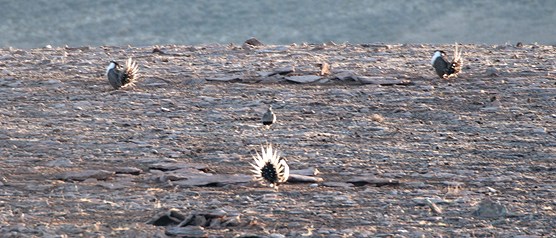
Lisa Lynch/NPS The Gunnison Sage-grouse (Centrocercus minimus) is a newly named species native to the Gunnison Basin and surrounding areas, recognized by the American Ornithological Union in 2000 as a separate species. It was formerly classified as part of the Greater Sage-grouse species (Centrocercus urophasianus). The Gunnison Sage-grouse is about 2/3 the size of the Greater Sage-grouse, has different coloration of tail feathers and a distinct mating ritual. Since the 1970's, researchers have been aware of the differences between the two birds. DNA testing and other studies by researchers from the University of Denver, Western Colorado University, and the Colorado Division of Wildlife contributed to the new species status of the Gunnison Sage-grouse. ConcernsThe Gunnison Sage-grouse was once native to Arizona, Colorado, New Mexico, and Utah. It is estimated that only 3000-4500 birds remain in isolated populations throughout southeast Utah and southwest Colorado today. The sage-grouse in the Gunnison Basin, including those in and around Curecanti National Recreation Area, account for the majority of these birds (88%). Gunnison sage-grouse populations are believed to have declined by more than 60% since the 1950’s, based on historic count and hunting harvest counts. What is being done?In 2014, Gunnison Sage-grouse were listed as threatened by the U.S. Fish and Wildlife Service and designated critical habitat within each subpopulation. USFWS has developed a series of documents to guide species recovery – Species Status Assessment, Recovery Plan and Recovery Implementation Strategy. What can you do?While visiting Curecanti National Recreation Area, Black Canyon of the Gunnison National Park and the Gunnison Country, there are simple things that each of us can do to show our concern for the Sage-grouse.
Additional ResourcesWestern Colorado University - The Gunnison Sage-Grouse |
Last updated: May 19, 2021
